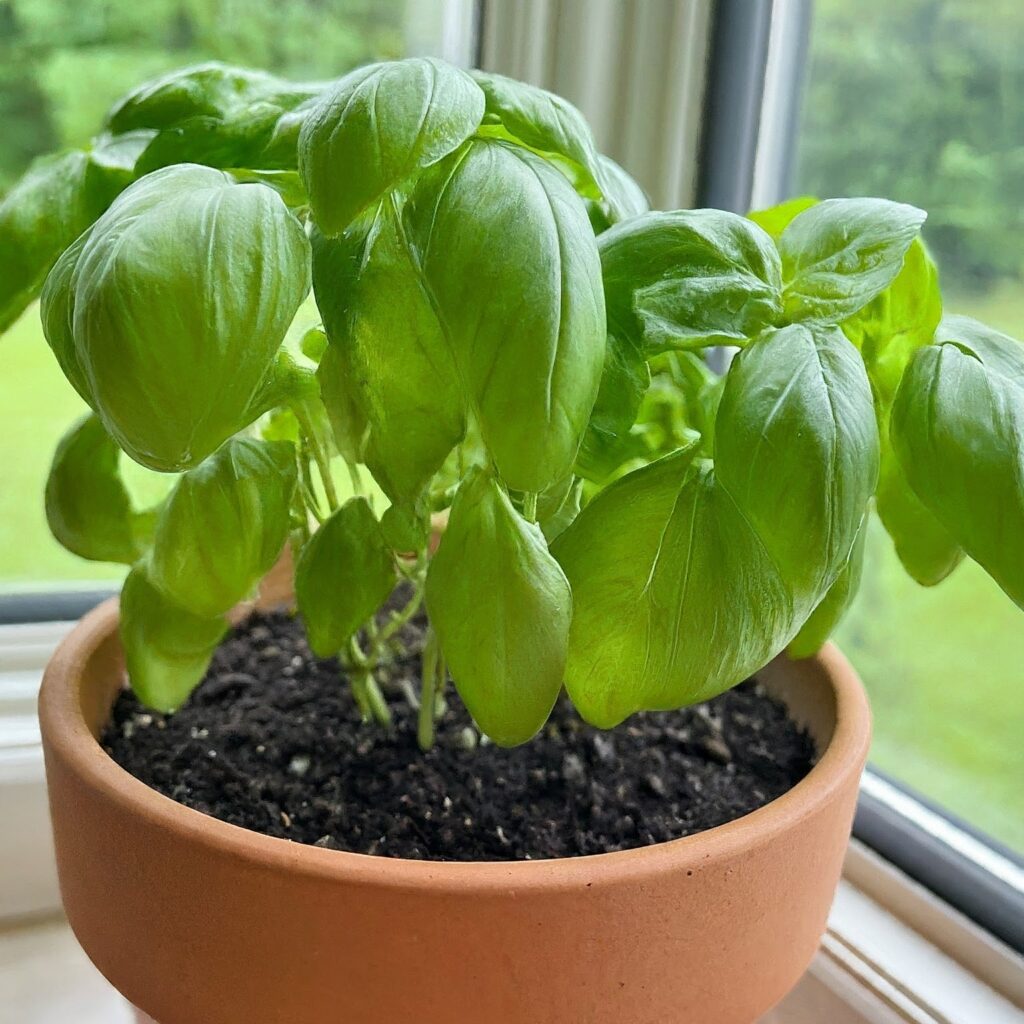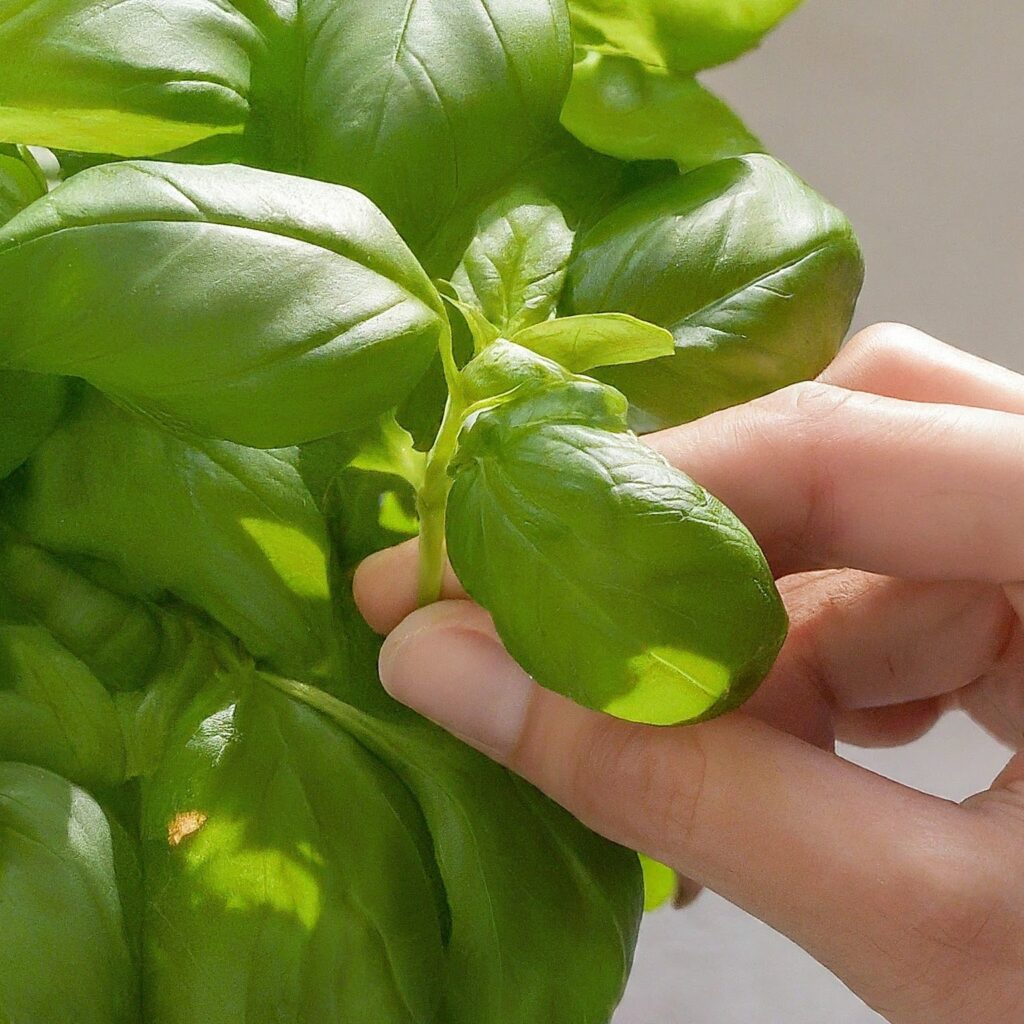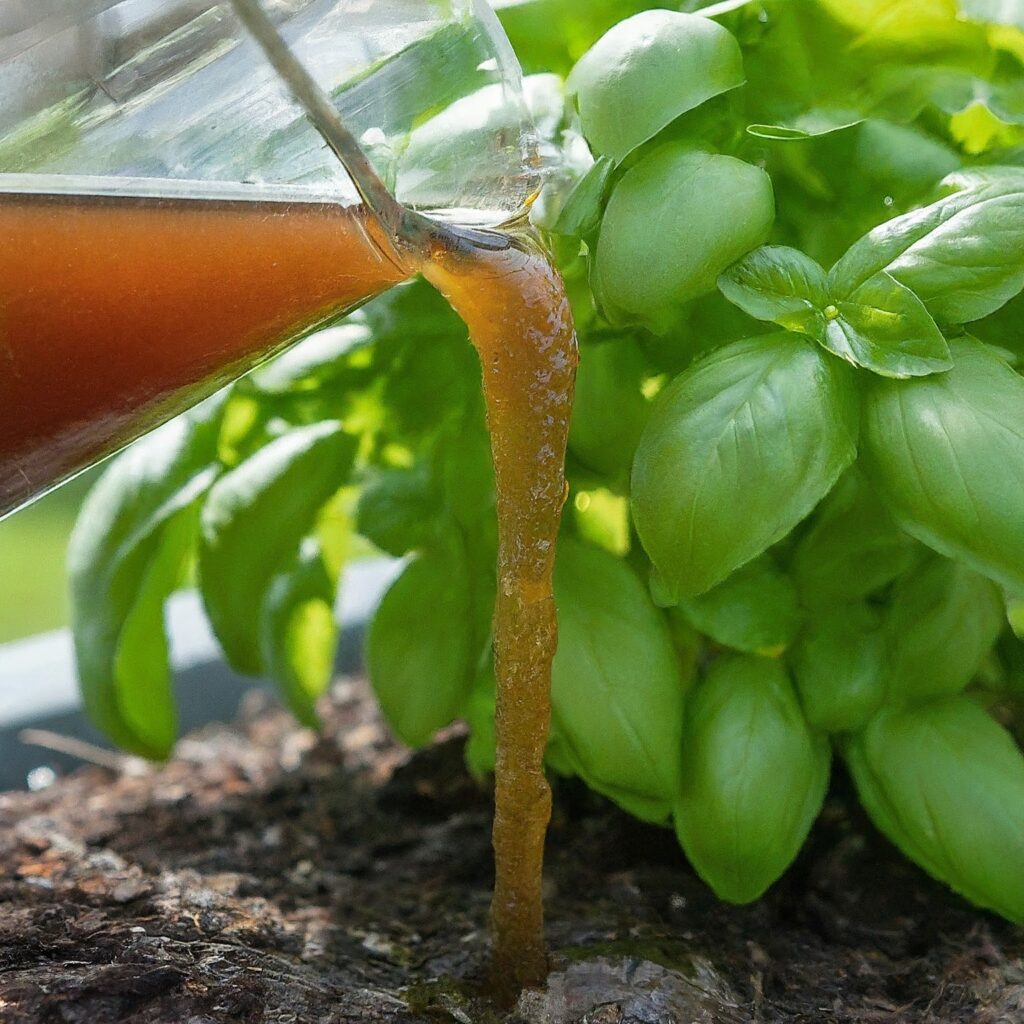Farewell Frost, Hello Flavor: Conquer Winter with Thriving Basil!
Remember the vibrant green leaves and intoxicating aroma of fresh basil, adding a touch of magic to your winter dishes? With a few clever tricks and winterizing wisdom, you can transform your basil from a fragile summer fling into a year-round culinary companion.
This guide unveils the secrets to mastering basil plant care in winter. Whether you’re a seasoned green thumb or a gardening newbie, get ready to embrace the thrill of fresh basil, even when snowflakes are swirling outside. So, grab your mug of hot cocoa, settle in, and let’s unlock the secrets to keeping your basil thriving all winter long!
Winterizing Your Basil: From Garden Hero to Indoor Superstar
As temperatures plummet and frost paints the landscape, your beloved basil might start looking a little worse for wear. With a gentle transition and some strategic adjustments, you can transform your summer hero into a thriving indoor companion ready to grace your winter dishes. Let’s embark on this basil plant care in winter journey, ensuring your leafy friend continues to flourish.
Step 1: Timing is Key: Like Cinderella at the stroke of midnight, there’s an ideal timeframe for bringing your basil inside. Watch the weather closely – ideally, move your plant before temperatures dip below 50°F (10°C) at night. This minimizes stress and helps it adapt smoothly. Remember, basil is a tropical soul, so don’t let it face the harsh realities of winter unprepared!
Step 2: The Right Potting Mix: Imagine your basil basking in a fluffy, well-draining paradise. That’s where the potting mix comes in! Opt for a light, airy mixture specially formulated for container plants. Steer clear of dense, water-retaining options that can suffocate your plant’s roots. After all, happy roots equal happy basil!

Step 3: Transplanting with TLC: Gently ease your basil out of its outdoor home and into its new indoor abode. Choose a pot slightly larger than the root ball to allow for future growth. Carefully loosen the soil around the roots to avoid damage, and nestle it comfortably in its new pot. Remember, a gentle touch is key to minimizing transplant shock.

Step 4: Acclimatization: A Gentle Introduction: Don’t expect your basil to adjust overnight. Gradually introduce it to its new indoor environment. Start by placing it in a sheltered location with indirect sunlight for a few days. This allows it to acclimate to the change in temperature and light before transitioning to its permanent sunny spot.

Remember: Throughout this basil plant care in winter process, pay close attention to your plant’s needs. If the leaves start wilting or yellowing, adjust your watering, light, or temperature accordingly. With a little love and attention, your basil will reward you with vibrant leaves and delicious flavor all winter long!
Winter Care Routine: Keeping Your Basil Thriving Indoors
Congratulations! You’ve successfully transitioned your basil from garden hero to indoor superstar. But the journey doesn’t end there. In fact, basil plant care in winter requires a slightly different approach than its summer counterpart. Don’t worry, though – it’s more like adjusting your wardrobe than a complete overhaul!
Watering Wisdom: Remember those carefree summer days where your basil guzzled water like a champ? Well, winter brings a shift in its thirst levels. Due to reduced sunlight and evaporation, water your plant less frequently. The key is to avoid soggy soil, which can invite root rot. Stick your finger in the soil – if it feels damp an inch down, hold off on watering. When you do water, aim for a thorough soaking that reaches the roots without leaving the pot standing in water.

The Pruning Powerhouse: Pruning isn’t just about keeping your basil neat; it’s a secret weapon for promoting bushier growth and preventing unwanted flowering (which reduces flavor). Regularly pinch off the growing tips just above a set of leaves. This encourages new branches to sprout, resulting in a fuller, more vibrant plant. Remember, winter basil grows slower, so don’t go overboard with pruning – a gentle trim every week or two should suffice.

Feeding for Flavor: While your basil might be less ravenous in winter, a touch of nourishment can go a long way. Instead of regular fertilizer, consider an occasional boost of diluted organic compost tea. This provides essential nutrients without the risk of overfeeding, which can harm your plant. Remember, less is often more when it comes to winter basil care!

Bonus Tip: Did you know research suggests regular pruning can increase the essential oils responsible for basil’s unique flavor? So, snip away with confidence, knowing you’re not just shaping your plant but enhancing its deliciousness!
By following these simple tips, you’ll provide your basil with the perfect winter haven, ensuring it continues to thrive and reward you with its aromatic leaves all season long. Remember, a little understanding and TLC go a long way in the world of basil plant care in winter.
Can I Bring My Basil Plant Indoors For The Winter
Whether you can bring your basil plant indoors for the winter depends on a few factors:
Your location:
- Warm climates (zones 10 and above): If you live in a warm climate where temperatures rarely dip below 50°F, you might not need to bring your basil indoors unless you expect prolonged periods of cold below that. However, if you notice the leaves blackening, it’s a sign of stress from the cold and bringing it inside might be a good idea.
- Cooler climates: If you live in a cooler climate where temperatures regularly fall below 45°F, it’s crucial to bring your basil indoors before the first frost. Temperatures below 45°F are dangerous for basil and can kill it.
Your basil plant:
- Health: A healthy, established basil plant is more likely to adapt to the transition indoors than a weak or stressed one.
- Size: Bringing a large, fully grown basil plant indoors can be challenging. Consider starting with smaller plants or cuttings for overwintering.
Overall, bringing your basil plant indoors for the winter is a good option if you live in a cooler climate or want to extend its lifespan. Here are some tips for success:
- Do it gradually: Don’t move your plant directly from full sun outdoors to a dimly lit corner inside. Acclimate it by placing it in a partially shaded area outdoors for a few weeks before bringing it fully indoors.
- Choose the right spot: Provide your basil with at least 6-8 hours of bright, indirect sunlight daily. A south-facing window or using grow lights is ideal.
- Adjust watering: Water your basil when the top inch of soil feels dry. Overwatering can be fatal indoors.
- Maintain warmth: Keep the temperature between 65-75°F and avoid cold drafts.
- Prune regularly: Pinch off flower buds and prune any leggy stems to encourage bushy growth.
With proper care, you can enjoy fresh basil from your plant throughout the winter and even start new plants from cuttings for the next season!
Troubleshooting Common Winter Woes: Keeping Your Basil Happy Indoors
Even with the best intentions, sometimes your basil plant care in winter might hit a few bumps. Most issues have simple solutions, and a little troubleshooting can keep your basil thriving. Let’s tackle some common winter woes:
Drooping Leaves: Is your basil looking a bit sad and wilted? Several reasons could be at play. Firstly, check the soil moisture. Remember, your plant needs less water in winter. If the soil is soggy, adjust your watering schedule to prevent root rot. Secondly, ensure your basil receives enough light. Move it closer to a sunny window (or consider supplementing with a grow light) if needed. Lastly, keep an eye for pests like aphids or spider mites, which can weaken your plant. If you spot any, address them promptly using organic methods like insecticidal soap.
Yellowing Leaves: Yellowing leaves can indicate various issues. Nutrient deficiencies due to infrequent feeding (remember, winter nourishment should be gentle!) might be a culprit. Consider a diluted organic compost tea boost. Alternatively, underwatering or cold drafts can also cause yellowing. Ensure your watering routine is appropriate and avoid placing your basil near drafty windows or vents.
Leggy Growth: Notice your basil reaching for the sky with long, thin stems? Lack of light is the usual suspect. Move your plant closer to a sunny window or invest in a grow light to mimic summer sunshine. Remember, adequate light exposure is crucial for basil plant care in winter and encourages compact, healthy growth.
Bonus Tip: Feeling overwhelmed? Don’t hesitate to consult reputable gardening resources or consult with experienced gardeners. The National Gardening Association offers plenty of helpful information on basil care. Remember, you’re not alone in your winter basil journey!
By understanding these common issues and their solutions, you can effectively troubleshoot any challenges your indoor basil might face. Remember, winter basil care is all about adjusting your approach and providing your plant with the essentials it needs to thrive. So, stay observant, adapt your care as needed, and enjoy the delicious rewards of fresh basil, even when the winter wind blows!
Basil Plant Wilted Overnight
Unfortunately, your basil plant’s sudden wilting overnight could have several causes. However, I can offer some initial troubleshooting steps:
First, check the soil moisture. Stick your finger an inch deep. If it’s dry, underwatering is likely the culprit. Give your plant a thorough watering until water drains freely from the pot. Conversely, if the soil feels soggy, overwatering might be the issue. Let the excess drain and avoid watering again until the top inch of soil dries out.
Next, consider other stressors. Did your plant experience a sudden temperature drop, too much direct sun, or recent repotting? These can temporarily shock and wilt a basil plant. Move it to a warmer, shadier spot if needed, and avoid further disturbances while it recovers.
Observe for pests or disease. Inspect the leaves and stems for signs of insects, discoloration, or webbing. If you find any, identify and treat them appropriately.
If the wilting persists or worsens, provide more details about your care routine, pot drainage, and any other observations. This will help narrow down the cause and recommend specific solutions to revive your basil plant.
Conclusion: Conquering Winter with Your Basil Companion
There you have it! With this guide, you’ve unlocked the secrets of basil plant care in winter. Remember, a little knowledge and TLC go a long way in transforming your summer hero into a thriving indoor companion. By following these tips, you can enjoy the vibrant greenery and delicious flavor of fresh basil all season long, even when the frost is on the windowpane.
So, embrace the challenge, get creative, and have fun! Experiment with different techniques, personalize your approach based on your plant’s individual needs, and don’t be afraid to ask for help from fellow basil enthusiasts or reliable gardening resources. Remember, every successful harvest starts with a little learning and a lot of love.
And now, the most important part: enjoy the fruits (or should we say, leaves!) of your labor! Infuse your winter dishes with the fresh zest of homegrown basil, share your bounty with friends and family, and bask in the satisfaction of nurturing life even in the colder months. With this newfound knowledge, you’ve become a true basil whisperer, ready to conquer winter and savor the taste of summer, all year round!
Bonus Tip: Feeling inspired? Why not try propagating your basil from cuttings to create even more leafy companions? It’s a fun and rewarding way to expand your indoor herb garden and share the winter basil love!
I hope this guide has empowered you to embark on your basil plant care in winter journey with confidence.
Basil Plant Care in Winter: Frequently Asked Questions
Q: Is it really possible to keep basil alive in winter?
A: Absolutely! With proper care, your basil can thrive indoors even when the temperatures drop. This guide provides all the information you need to create a flourishing winter haven for your plant.
Q: What’s the biggest challenge for basil in winter?
A: Lack of sunlight is the main hurdle. Basil craves sunshine, so mimicking summer light with a sunny window location or grow lights is crucial.
Q: How often should I water my basil in winter?
A: Less is more! Water your plant less frequently than you did in summer. Check the soil moisture – if it feels damp an inch down, hold off on watering.
Q: Do I need to fertilize my basil in winter?
A: Regular fertilization isn’t necessary. Instead, consider an occasional boost of diluted organic compost tea for gentle nourishment.
Q: My basil leaves are drooping. What’s wrong?
A: Several possibilities exist – underwatering, overwatering, lack of light, or pests. Check the soil moisture, light exposure, and rule out any pests like aphids or spider mites.
Q: My basil leaves are turning yellow. Why?
A: Nutrient deficiencies, underwatering, or cold drafts can cause yellowing. Consider a diluted compost tea feeding, adjust your watering schedule, and ensure your plant isn’t near drafty areas.
Q: My basil is growing tall and leggy. What can I do?
A: Lack of light is the likely culprit. Move your plant closer to a sunny window or invest in a grow light to encourage bushier growth.
Q: Can I propagate my basil for more plants?
A: Absolutely! This article briefly mentions how to propagate from cuttings, allowing you to expand your indoor herb garden.
